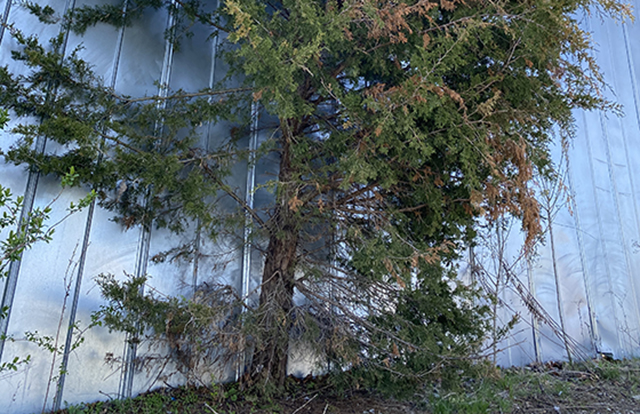Haga clic aquí para encontrar esta información en español.
Just like the coronavirus penetrates the inside of humans and hijacks the nucleus of its cells, this fungus, known as the cedar-apple rust, damages leaves and accesses the inside of its cones to grow spore horns that become gelatinous with the first rains of the season. As its name indicates, Eastern red cedar, apples and crabapple trees are its main hosts.

Interestingly, the same way Covid-19 spreads through the air in tiny particles, the cedar-apple rust releases microscopic spores that are carried by the wind to spread and infect others and, needless to say, it may also affect the health of the infected organism to the point of making it perish.
Although, there is no clear scientific evidence about how the summer months may slow the spread of the pandemic, when I found this apple-rust gall in a tree around the corner of my house last week, I hoped that the coming more frequent rays of sun may give us a break like this cedar tree may better fight its vector when the temperatures increase.
Tras la Tempestad Llega la Calma
A primera vista, puede parecer una mutación macroscópica del temido virus. Sin embargo, se trata de una agalla en las piñas de un cedro también conocido como sabina colorada de Virginia (Juniperus virginiana). Las agallas son malformaciones que ocurren en plantas y árboles cuando se ven atacados por insectos, hongos, bacterias o virus.
De igual forma que el coronavirus penetra en el interior de los humanos y controla el núcleo de sus células, este hongo, llamado óxido del cedro y del manzano, daña sus hojas y accede al interior de sus piñas para reproducirse en forma de esporas alargadas que se vuelven gelatinosas con las primeras lluvias de la estación. Como su nombre indica, el cedro y el manzano son los árboles a los que invade e infecta.

Curiosamente, al igual que el coronavirus se contagia por pequeñas partículas que viajan por el aire, el hongo en cuestión también libera esporas al aire que el viento se encarga de transportar para infectar otro organismo y, ni que decir tiene, también puede afectar la salud de su víctima hasta hacerlo perecer.
Aunque no hay evidencia científica que demuestre que los meses de verano puedan diminuir los contagios de esta pandemia, cuando encontré este óxido del cedro y del manzano en un árbol a la vuelta de la esquina de mi casa, sentí la esperanza de que los próximos y cada día más frecuentes rayos de sol puedan darnos un respiro así como este cedro puede luchar mejor contra este vector cuando las temperaturas aumenten.






